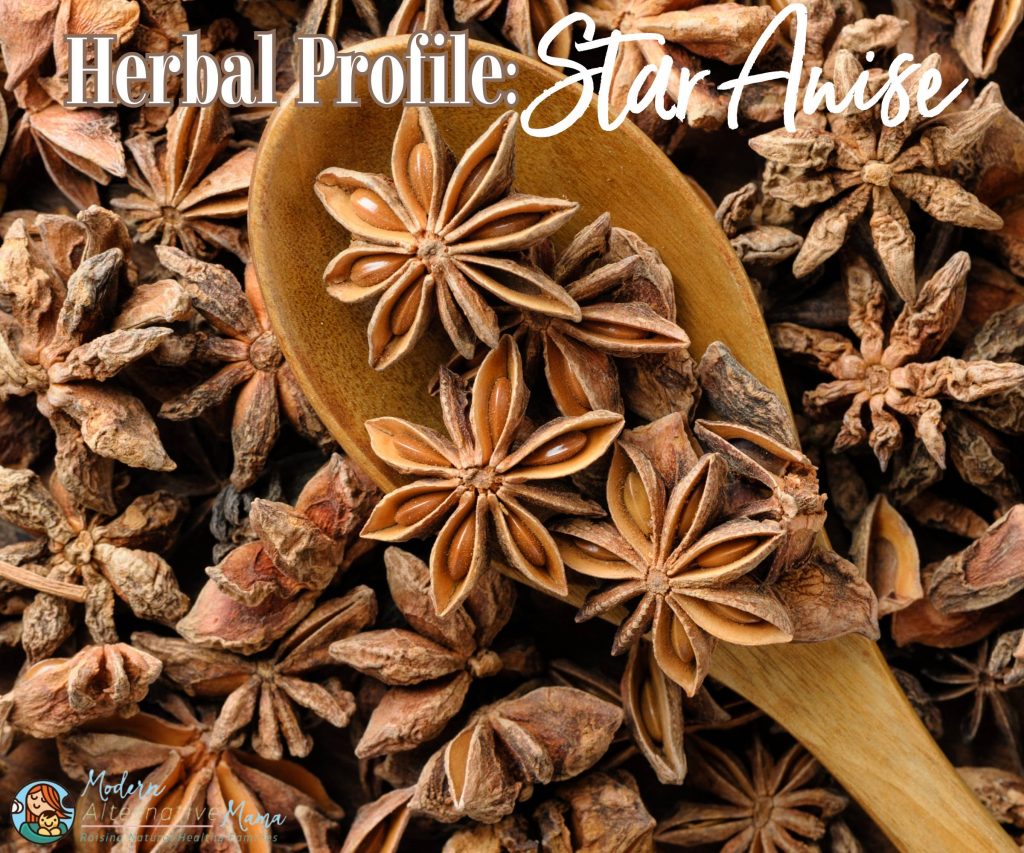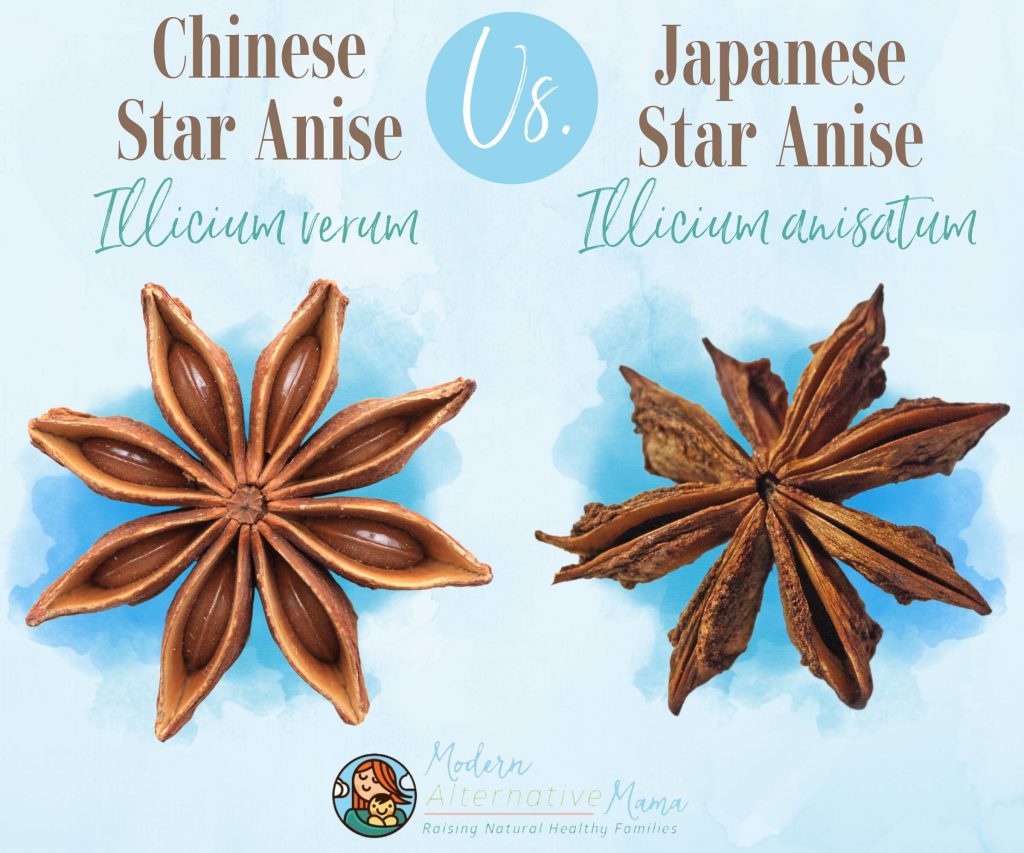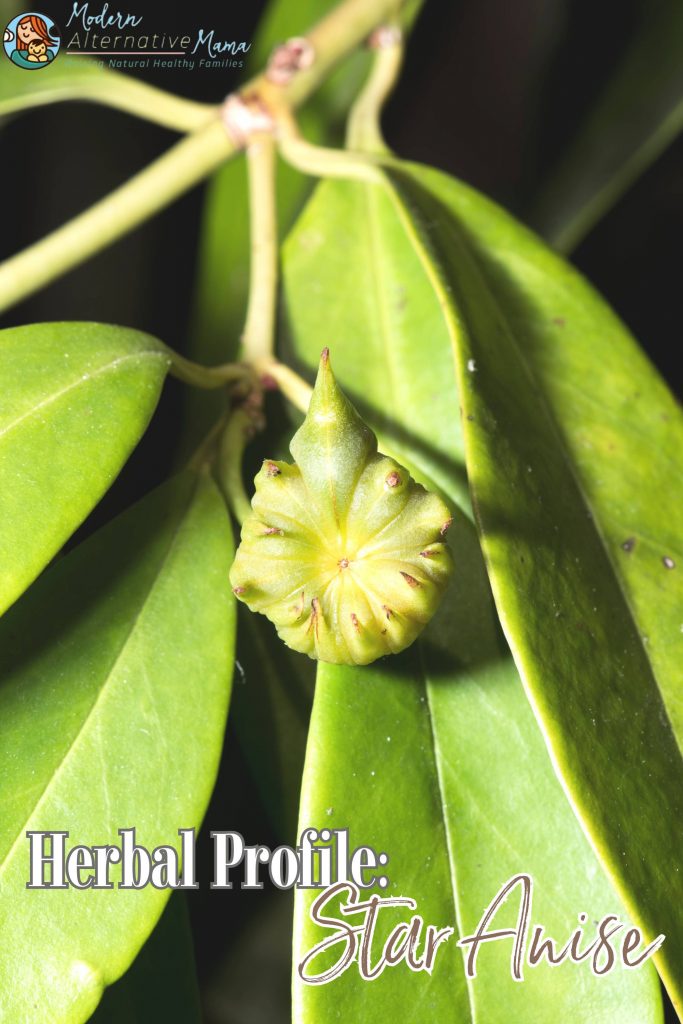What is Star Anise
Star anise, sometimes called star aniseed, Chinese star anise, or its scientific name Illicium verum, is a member of the Schisandraceae family (1). Star anise comes from a tropical evergreen tree that can be identified by its large, glossy greenery and beautiful, star-shaped, reddish-pink flowers. The flowers produce fruit pods known as star anise, not to be confused with toxic Japanese star anise (Illicium anisatum), whose tree has white flowers (2).
While on the tree, Chinese and Japanese star anise are easily distinguishable by the flowers. Another key difference is that Japanese star anise is smaller than star anise. When dried, the characteristics of the two fruit pods become a little harder to differentiate. Japanese star anise has a weaker aroma, with petals thinner at the base and pointed at the end. In contrast, star anise has fat, round petals, and a stronger aroma similar to cardamom (3).
Health Benefits of Star Anise
In the pharmaceutical industry, star anise is known for its anti-influenza properties, which were synthesized to create the commonly prescribed drug Tamiflu (oseltamivir). In the herbal world, star anise is respected for its many medicinal benefits, such as:
Antioxidant Properties
Antioxidants can help fight damage from harmful free radicals. The buildup of free radicals has been linked to chronic diseases, such as cancer and heart disease (4). Thankfully, studies demonstrate star anise’s antioxidant activities (5). An animal study found star anise tea protects against obesity and oxidative stress in high-fat-sugar diet-induced obese rat models (6). Another animal study discovered star anise significantly reduced inflammation and oxidation compared to mice treated with bacterial toxin lipopolysaccharide (7).
Antibacterial Properties
An antibacterial property is when a substance, or in this case, an herb, can destroy or suppress the growth and reproduction of bacteria (8). One study found star anise semi-effectively reduced the growth of E. coli in a petri dish (9). Another study found star anise was one of many herbs to effectively manage multidrug-resistant urinary tract-infecting bacteria in vitro (10). One study concluded that star anise extracts can be further developed into antibiotic medicines (11).
Antifungal Properties
An antifungal property is when a substance, or in this case, an herb, can fight the growth of specific pathogens that could harm your health, such as ringworm, athlete’s foot, tinea versicolor, toenail fungus, and jock itch (12). In vitro, compounds like linalool, found in star anise essential oil, demonstrated antifungal properties (13,14). Some research has discovered that one of star anise’s components, trans-anethole, has antifungal properties that can be used to develop natural fungicides for plant disease control (15).
Antiviral Properties
An antiviral property is when a substance, or in this case, an herb, can kill a virus or suppress the virus’ ability to replicate, multiply, or reproduce (16). In vitro, star anise essential oil has demonstrated antiviral activity against herpes simplex type 1 (17). Studies have also found star anise effective against the flu, a viral respiratory illness impacting about 8 percent of the American population annually (18).
“Compound 7 [(-)-bornyl p-coumarate] showed strong antiviral activities against influenza virus A/Puerto Rico/8/34 H1N1 (PR8) with an IC50 value of 1.74 ± 0.47 μM, which is much better than those of Tamiflu (IC50 = 10.01 ± 0.92 μM) and ribavirin (IC50 = 10.76 ± 1.60 μM) (19).”
In other words, star anise has greater antiviral/anti-influenza properties than the pharmaceutical industry’s synthesized version of the herb. Star anise’s antiviral properties are so potent its tea was used as a natural immunomodulator during covid (20).
May Reduce Blood Sugar Levels
As of 2020, 34.2 million (1 in 10) Americans have diabetes, and another 88 million (1 in 3) Americans have prediabetes (21). In animal studies, one of star anise’s essential oil constituents, anethole, reverted enzymes to near-normal levels in the liver and kidney of diabetic rats (22,23). Another study found diabetic rats experienced significantly decreased blood sugar levels when given 150 milligrams of star anise extract per kilogram of body weight (24).
May Promote Heart Health
Unfortunately, heart disease is the world’s number one cause of death (25). Due to the incredibly complex determinants of heart disease and various possible contributions, it’s hard to pinpoint an exact way to prevent it. Still, you can at least take steps to lower your overall risk.
That’s where star anise may come in. In animal studies, star anise extract significantly decreased iNOS-mediated inflammatory responses while reducing plaque buildup and normalizing weight, blood pressure, and lipid levels (26). Another animal study found star anise improved body weight and blood pressure in rats fed a high-fat diet (27).
Anticancer Properties
Statistics say that 158.3 of every 100,000 individuals will die from cancer, but what if they didn’t have to (28)? One study categorized star anise extract’s polysaccharide production as having antitumor effects (29). Another study found star anise essential oil effective against several human colon cancer cell lines (30). A final study concluded that star anise extract has potent anticancer properties against MCF-7 cells through cytotoxicity, reduction, and inhibition of breast cancer cells and inducing apoptosis (31).
Safety Concerns
Mainstream sources like WebMD claim that although star anise is commonly consumed in food, it’s possibly unsafe as a tea due to potential contamination with poisonous Japanese star anise (Illicium anisatum). They claim it is impossible to tell if a product contains the contaminant, which would be true for anything, not just star anise.
WebMD also claims star anise can cause serious side effects when used in large doses, but they do not specify these serious side effects. They used the same contamination reason as to why they recommend children and those who are pregnant and breastfeeding stay on the safe side and avoid star anise. More specifically, they state:
“It is possibly unsafe for star anise to be taken by mouth in children. Serious side effects, including vomiting and seizures, have been reported in infants and adults given star anise tea (32).”
I’m not a fan of claims without evidence, so I started researching children having seizures after consuming star anise tea. The first study I found was seizures induced by Japanese star anise (Illicium anisatum) contamination, not star anise (Illicium verum) (33). Another study mentioned seven cases of adverse neurologic reactions in infants, but that study also found evidence of Japanese star anise contamination (34). Interestingly, both study’s titles are misleading, as if star anise was the cause.
If you’re concerned about contaminated star anise tea, the best way to ensure your tea isn’t contaminated is to make your own with fresh star anise. I recommend getting your herbs from a trusted source like Anthony’s Goods, Frontier Co-Op, or Starwest Botanicals.
Although trusted herbalist Richard Whelan has no information on star anise, Mountain Rose Herbs says there are no known precautions (35).
When it comes to essential oils, trusted aromatherapist Wendy Robbins cautions never to use them internally or undiluted. She also warns star anise essential oil has various precautions for those with hypersensitive skin or skin problems. She recommends avoiding star anise essential oil with children under five years old and those pregnant and breastfeeding. Additionally, she recommends a dermal maximum of 1.75% (36).
How to Use Star Anise
You can find star anise in dried bulk, pills, powders, teas, extracts, or tinctures. Tinctures usually contain the most concentrated amount of herbs. Teas and soups are also options, especially when following Ayurvedic medicine recipes. If you’re a DIY person, some great starter recipes are:
- How to Make an Alcohol Extraction (With Almost Any Herb) – to make a star anise tincture
- How to Make a Glycerin Extraction (With Almost Any Herb) – to make an alcohol-free star anise tincture
Disclaimer: This post is not intended as medical advice. These statements have not been evaluated by the FDA, and nothing in this post is intended to diagnose, treat, or cure anything. If you have questions, please do your own research or seek advice from a health professional.








